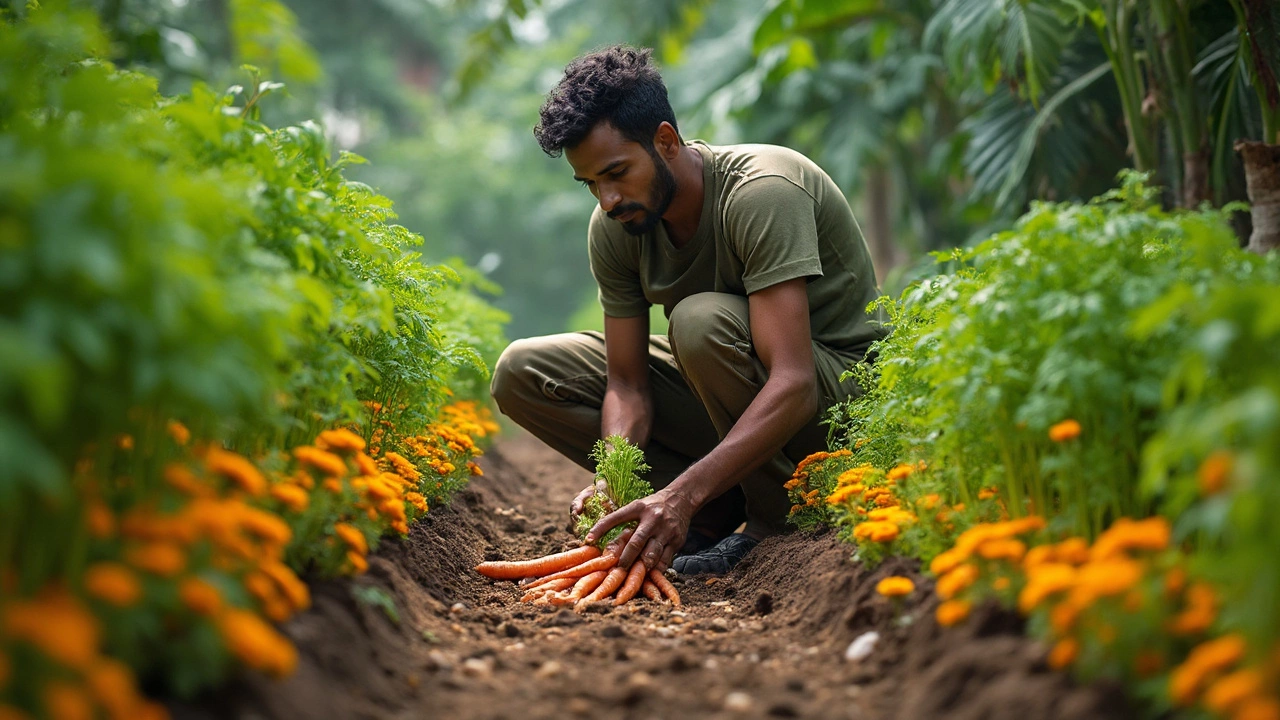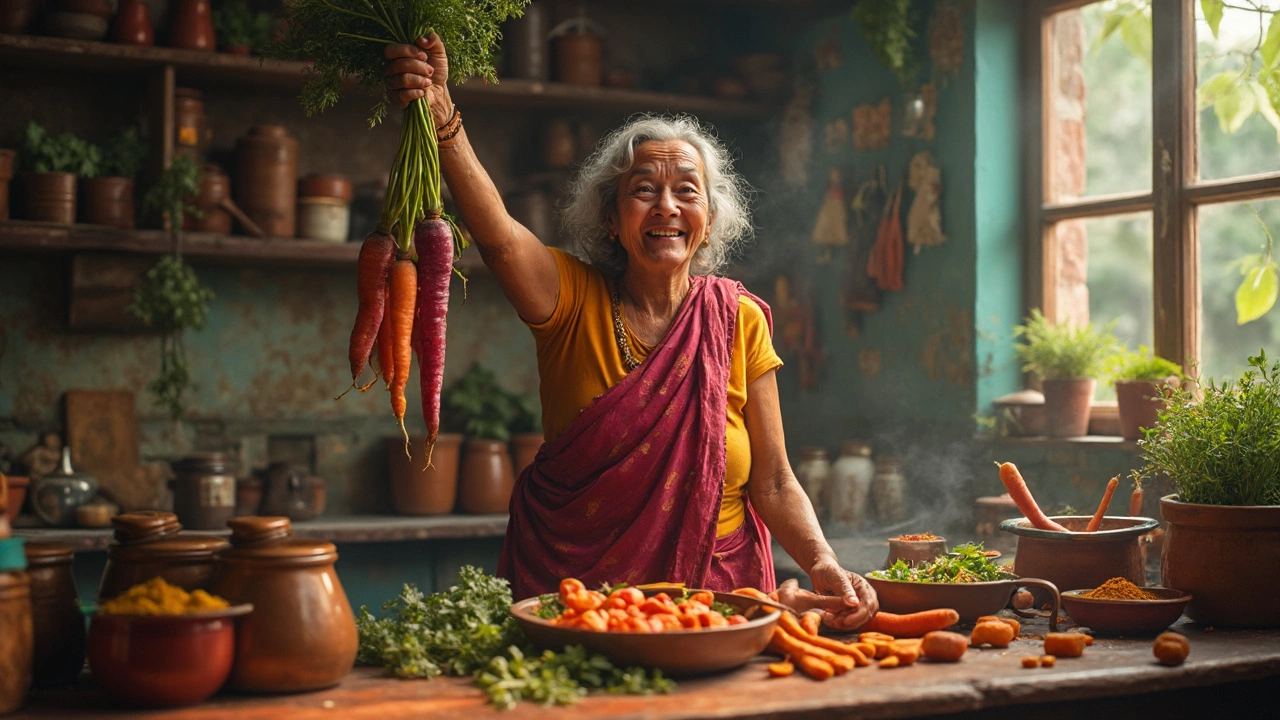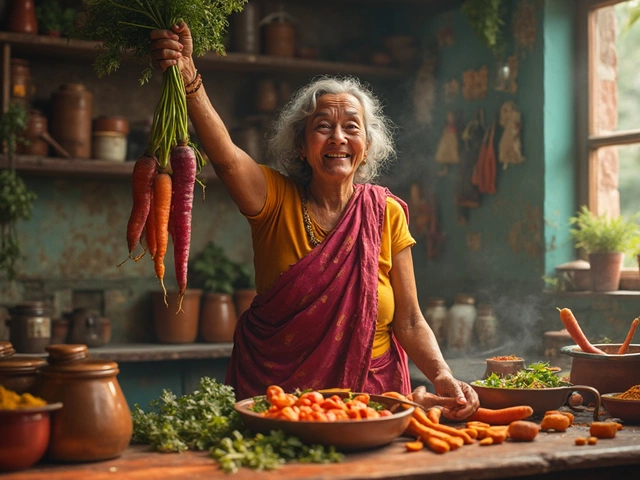Most of us just toss carrots into our curries or salads without even thinking about where they started out. There’s actually a pretty wild history behind them, and nope—they didn’t pop up first in India. If you ask a bunch of people around here, some will swear carrots were always part of Indian farming because they fit so well in dishes from gajar ka halwa to simple sabzis. But the real story is different.
Knowing where your carrots come from isn’t just a fun fact for quiz night—if you’re into gardening, it helps you pick the right varieties for your plot, plan your planting properly, and stop blaming yourself if those orange roots turn out tiny or oddly shaped. There’s a legit reason why carrots act up in different states and soils across India. If you ever stood at a vegetable stall and wondered if those red and orange carrots have their roots in Indian dirt or somewhere else, you’re about to find out. We’ll break down the journey of carrots, why they’re so common in India now, and how you can make sure your homegrown ones come out sweet and crunchy every time.
- Where Did Carrots Originally Come From?
- How Carrots Became Popular in India
- The Different Types of Carrots in India
- Best Tips for Growing Carrots Locally
- Fun Carrot Facts and Troubleshooting
Where Did Carrots Originally Come From?
If you picture a bright orange carrot growing wild in some old-school Indian field, think again. The original carrots weren’t orange at all, and they definitely didn’t start out in India. Most researchers pin their roots to Central Asia—mainly around modern-day Afghanistan and Iran. Thousands of years ago, wild carrots were purple or even yellow. They were pretty tough and not nearly as sweet as the ones we throw into our sambar or salads today.
The oldest records on carrots go back over 5,000 years. Ancient writings from Persia (now Iran) mention them, but these were basically medicinal roots, not a dinner star. Back then, people cared more about the seeds and leaves than the root. Some of these old varieties were even used to treat illnesses or spice up medicine, not food.
So how did carrots India know today get so orange and sweet? That didn’t happen until carrots traveled west. In the 16th and 17th centuries, Dutch farmers started breeding these roots into the classic orange kind. Basically, people selected the sweeter, juicier roots and kept replanting them. Soon the orange carrot became the most popular, and it spread to all corners of the world—including India.
- Wild ancestors: Afghanistan, Iran and nearby regions.
- First cultivated use: Not for eating, but for medicine and seeds.
- Orange carrots: Bred in the Netherlands in the 16th–17th centuries.
Check the table for a quick look at how growing carrots changed through time:
| Era | Region | Carrot Type | Main Use |
|---|---|---|---|
| 5,000+ years ago | Central Asia | Purple, yellow, tough | Medicinal |
| Middle Ages | Persia to Europe | Purple, red, yellow | Food, medicine |
| 1600s | Netherlands | Orange, eaten for taste | Food |
This spread wasn’t instant, but once people figured out how easy growing carrots could be, and how sweet they can taste, they never really left the dinner table.
How Carrots Became Popular in India
Carrots might not be native to India, but they’ve found a solid place in kitchen gardens and recipes around the country. Originally, wild carrots grew in places like Iran and Afghanistan. From there, they made their way across Asia, arriving in India by about the 10th century, probably through trade routes and travelers looking to try new crops.
The first carrots India saw weren’t even orange; they came in shades of purple, red, and yellow. It’s the red and purple carrot varieties that stuck in North India, especially in places like Punjab and Uttar Pradesh. That’s why, if you go veggie shopping in Delhi during winter, you’ll spot those long, sweet red carrots perfect for gajar ka halwa.
By the 17th century, when orange carrots became popular in Europe, they also started showing up in Indian markets, thanks to colonial trade. But for ages, the Indian crowd preferred their local red ones over the orange imports. Even now, red carrots sell out fast in season, especially in North India.
The spread of carrots in Indian food habits came down to three things:
- The ease of growing them during the cool season in most Indian states
- Their natural sweetness, which went well in both sweets and curries (plus, who says no to something that makes halwa taste better?)
- Rising awareness that carrots are good for your health, filled with vitamins and a solid option for veggie-focused diets
If you look at city veggie markets today, growing carrots has totally caught on. Local farmers have adapted the crop to work with Indian conditions, so now there’s a mix of native-style red and purple carrots, hybrid varieties, plus the now-classic orange too. For anyone keen on Indian gardening, carrots are clearly here to stay.
| Carrot Variety | Popular Region | Main Season |
|---|---|---|
| Red/Purple Carrot | North India | Winter |
| Orange Carrot | All India | Winter/Spring |
| Yellow Carrot | Limited | Winter |
So if you see both red and orange carrots battling for space on your thali or at the mandi, just remember, it’s all thanks to hundreds of years of travel, swaps, and people figuring out what tastes best in Indian kitchens.

The Different Types of Carrots in India
Walk into a local market, and you’ll notice it right away: Indian carrots are not all the same. You’ll see some fat and bright orange, others thinner and with a deep red color. The contrast is not just about looks—it actually changes the taste, texture, and how you use them at home. Let’s clear up what you’re biting into next time you buy carrots in India.
Red Carrot (Desi Gajar): This is the classic winter favorite, especially in North India. Red carrots pop up everywhere from November to February and are softer, sweeter, and juicier than the usual orange types. They’re the go-to for making gajar ka halwa, and their bright color isn’t just for show—it actually packs more lycopene, an antioxidant.
Orange Carrot: The orange carrot is what most of the world knows as "carrot." These varieties started showing up more in India over the last few decades. They tend to be firmer and less sweet than the red type, but they last longer in the fridge. If you’ve ever picked up carrots from a supermarket chain or made a salad in summer, it was probably this kind. The orange color comes from beta-carotene, another antioxidant your body converts into vitamin A.
Black Carrot (Kali Gajar): These aren’t common in every part of India, but you’ll find them in Punjab, Haryana, and Rajasthan during some winters. Used in traditional drinks like kanji, black carrots are rich in anthocyanins, which is what gives them that deep purple-black color.
Here’s a breakdown that might help the next time you’re at the veggie market:
| Type | Main Season | Main Uses |
|---|---|---|
| Red Carrot | Winter | Halwa, salads, juice |
| Orange Carrot | All year | Salads, curries, snacks |
| Black Carrot | Winter | Kanji, pickles |
If you’re growing carrots in India, keep your eye on local seed options. Desi red carrots usually need cooler weather (ideal from October to January), while orange ones can manage with the warmer months in many states. Commercial farms now offer hybrid types too, which try to mix the sweetness of reds with the firmness of orange varieties. Just watch out: hybrids grow fast, but might taste a bit more bland than the old-school reds your nani used to buy.
Best Tips for Growing Carrots Locally
If you want your carrots India to turn out sweet, straight, and crunchier than anything from the market, the secret’s in the soil and timing. Carrots are a bit picky—get it right and you’ll be bragging to neighbors when you pull up those perfect roots.
First off, soil makes or breaks your carrot crop. Go for loose, sandy loam with no stones or compacted lumps. Hard soil makes carrots fork and twist—think of those weird shapes you sometimes see at the market. If you’ve only got clay, mix in old compost or sand to loosen it up.
- Right season: For most of India, the best time to plant is October to February. North India folks should avoid peak winter; South India can stretch the season since winters there are milder.
- Seed spacing: Sow seeds about 1cm deep and leave 4-5cm between each one. If you throw seeds randomly, expect a tangle instead of neat rows.
- Water smart: Keep the top layer of soil moist until seedlings show up. After that, water once or twice a week. Carrots hate waterlogging—oversaturate and they’ll rot.
- Carrot varieties: Want red carrots for halwa? Try “Pusa Rudhira Red.” For classic orange, look for “Nantes” or “Danvers.” Pick based on what grows best in your climate.
Growing carrots in containers? At least 30cm (about a foot) deep is a must, or your carrots will stay stunted. - Feed lightly: Too much fertilizer, especially nitrogen, makes carrots grow lots of leaves but skinny roots. Compost or vermicompost is safe and gentle.
- Watch for pests: If small holes appear, it could be carrot fly or root nematodes. Covering young plants with a fine mesh can head off bugs, and rotating crops each year keeps most soil pests away.
Here’s a quick glance at carrot-friendly conditions:
| Condition | Ideal Range |
|---|---|
| Soil pH | 6.0 - 7.0 |
| Temperature for germination | 15 - 25°C |
| Depth of sowing | 1 cm |
| Spacing between plants | 4 - 5 cm |
Don’t forget to thin seedlings once they’re a couple of inches tall—if you skip this, the roots will struggle for space and nutrients. Thinning feels harsh, but it’s a game-changer for straight, plump carrots.
Last tip: resist pulling them up too early! Most growing carrots need 75-90 days to mature, depending on the variety. Patience pays off with roots that are actually worth showing off.

Fun Carrot Facts and Troubleshooting
Let’s be honest—carrots might seem plain, but there’s a lot going on beneath that crunch. If you ever wondered how many types of carrots are actually common in India or why your homegrown roots look nothing like what you see at the market, you’re not the only one. Let’s get into some quick carrots India facts before we roll into fixing common headaches in growing carrots at home.
- Carrots weren’t always orange. Ancient carrot roots found in Central Asia were purple, yellow, or even white. Orange varieties got really popular after the 16th century, mostly thanks to Dutch farmers.
- The classic Indian red carrot ("desi gajar") isn’t just for halwa. It usually pops up in North Indian markets from December to March, making it a seasonal favorite.
- When it comes to nutrition, carrots pack beta-carotene (which your body turns into vitamin A), and they’re also a solid source of fiber. Eating just 100 grams of carrots can give about 334% of your daily vitamin A needs.
Even if you nail the basics, sometimes growing carrots in your pot or kitchen garden just doesn’t work out. Here’s what can go wrong and how to fix it so you get those crisp, tasty roots every season:
- Root Forking or Twisting? Usually, it means there are little stones or hard clumps in your soil. Carrots want loose, sandy soil—grab a sieve, break up tough earth, or use raised beds with fresh soil.
- Carrots Growing Small? Maybe they’re planted too close. Thin the seedlings out so each one has room to get fat—leave about 3–4 cm space between them.
- Tiny Green Shoulders? If your carrot tops are poking above soil and turning green, just heap more soil around them. It stops bitterness and keeps them looking clean.
- Cracking or Splitting? Carrots hate big mood swings when it comes to water. If you forget watering for a week and then overcompensate, they split. Stick to regular, even watering.
- Pests or Fungus? Watch out for white "webbing" or little tunnels—that’s the carrot fly or nematodes. Use mesh nets, rotate spots you plant each year, and always pull out old root scraps at harvest.
Curious about the most common types grown in India? Here’s a snapshot:
| Carrot Type | Color | Main Season |
|---|---|---|
| Desi Red | Deep Red | Winter (Nov-March) |
| Orange Nantes | Bright Orange | Spring/Summer |
| Pusa Asita | Purple/Black | Winter |
| Kuroda | Orange | Year-round (best in North/West India) |
One last thing: store your carrots unpeeled in a cool part of the fridge, inside a loose bag. This keeps them fresh longer and slows down wilting. And never toss those carrot tops—they’re totally edible and work great in chutneys or as a salad sprinkle.


